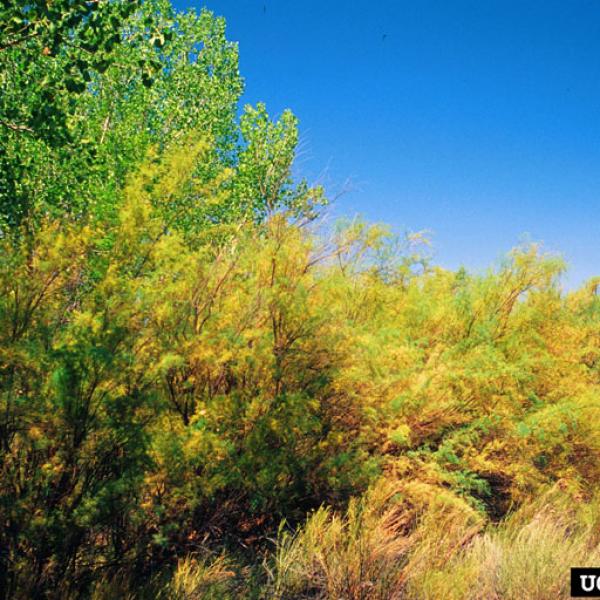
"The tiny seedling was brought over from Eastern Europe and parts of Asia nearly 200 years ago and planted along riverbanks across the United States, mostly in the Southwest, to prevent erosion. It grew fast, its thick branches and oily leaves spreading across five states. As years passed, it became obvious that the introduction of salt cedar, or Tamarisk trees was a mistake. The invasive tree has an extensive root system that sucks up nearby water and leaves that leak a salt-like substance, killing native plants. It also burns hot in wildfires -- complicating efforts to control them -- and afterward is quick to grow back.
Salt cedar's resiliency makes containing and treating it a continual, almost never-ending task. Here's a closer look at the tree and what's being done about it in the West:
What Is Salt Cedar?
Salt cedar has the potential to grow as tall as a two-story building, with large, thick branches. It was brought to the U.S. as a method to prevent erosion along bodies of water like the Colorado River.
The invasive plant is difficult to eradicate because of its robust root system that can extend as deep as 25 feet, according to the Tamarisk Coalition, a Colorado-based organization working to address non-native plants in the West.
Additionally, it can survive and re-sprout in high stress conditions like floods, droughts and wildfires. Often when salt cedar is cut down or sprayed, it has the potential to grow back, requiring crews and groups to keep treating it.
Why Is It So Problematic?
Salt cedar creates extreme fire conditions because of how hot and black it burns. Containing wildfires burning in salt cedar can be difficult and dangerous for crews on the ground and typically requires heavy machinery like bigger trucks or aircraft.
The fire department in the Phoenix suburb of Avondale fights such fires with Type III Brush truck, which is larger and sturdier than a regular fire engine and has a more extensive hose system, Capt. Steve Mayhew said.
What's unique about salt cedar's biological makeup is that after it burns, a reaction in the tree allows it to sprout back with more vigor.
"It grows a whole new plant on top of what was burned, essentially," said Rusty Lloyd, program manager at the Tamarisk Coalition.
Not only is salt cedar fueling many of the fires in the Southwest, it also is altering the environment around it by reducing wildlife habitats, agriculture and "water quality and quantity," Lloyd said.
What's Being Done?
Government agencies, groups and communities have taken initiative in trying to control the plant's spread.
Arizona has seen a boost in efforts to clear salt cedar by independent organizations like the Friends of Verde River Greenway, led by Anna Schrenk.
In the summer months, Schrenk's crew maps areas where salt cedar was treated in previous years. The group uses tablets and a special application that pinpoints where the plant has or hasn't grown back. This method makes it easier for crews to return in the fall and start physically clearing any regrowth.
Crews usually use chain saws to cut down the trees and then treat them with an herbicide. Other methods include plowing down salt cedars with a "large lawn mower" or in rare cases, bulldozers, Lloyd said.
An unauthorized release of a Tamarisk-eating beetle in Utah was conducted in 2006 to try and kill the invasive tree, the Tamarisk Coalition said. The beetle slowly made its way into northern Arizona around 2008.
The bug is eating away at salt cedar, but it also threatens the habitat of an endangered bird, the southwestern willow flycatcher. As willow trees in the Southwest have decreased, the small birds started using Tamarisk as their preferred habitat.
What's Next?
Groups and landowners are focused on controlling growth in areas where salt cedar is densest, including Arizona, Colorado, Utah, New Mexico and Nevada.
Their main goal is to replant native plants, replacing salt cedar to create a healthier and more abundant ecosystem.
Government agencies are working with communities like Buckeye to assist and fund salt cedar clearing, said Dolores Garcia, fire mitigation specialist at the Bureau of Land Management.
Regardless of these various initiatives, experts say they don't anticipate salt cedar going away anytime soon.
"There's a lot of work to do," Lloyd said. "It will not be eradicated. There will always be Tamarisk with us." "
Article Credit: Associated Press under contract with NewsEdge
Photo Credit: W. Ciesla, "grove of salt cedars", CC BY-NC 3.0 US http://www.ipmimages.org/browse/detail.cfm?imgnum=1428093